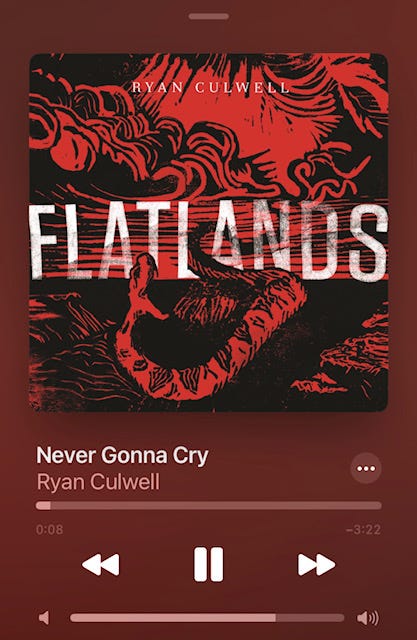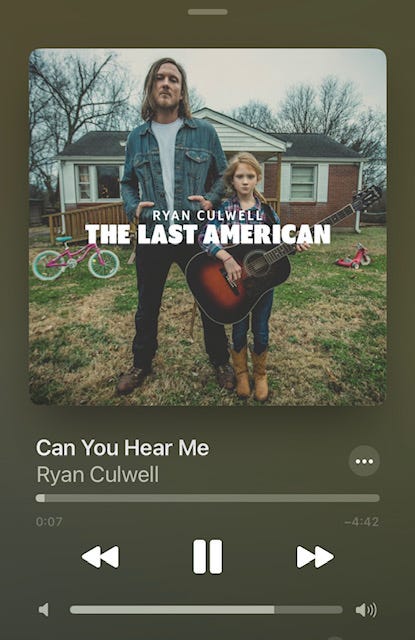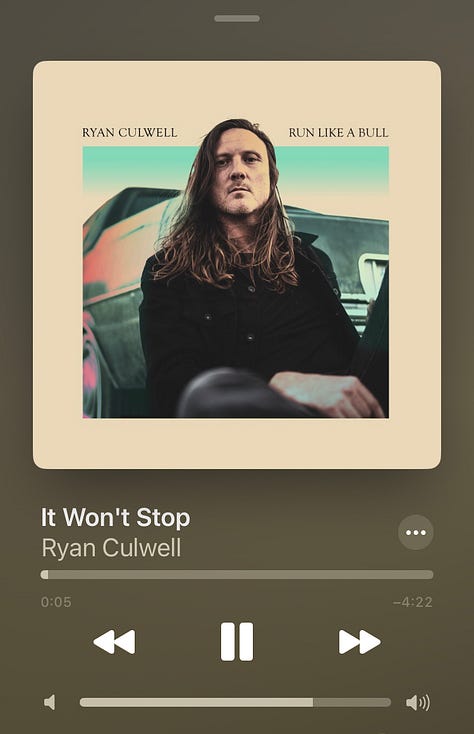
In the last issue, Dancehall Beauty, I wrote about the difference between Fine Arts and Industrial Arts using Ryan Culwell as an example. Since today is the one year anniversary of his most recent album Run Like a Bull, I thought I’d follow it up with a close read of three songs from across all three of his (public) albums.
Established in 1946, the Golden Light Café is likely the longest continually running restaurant on that ribbon of highway known as Route 66. It’s a narrow galley of a diner with screen doors on the front and back. The bar and grill occupy a quarter of the square footage. If you get there at the right time, you can sit at the bar with guys who have burgers named after them.
In 1996, the Golden Light Café expanded eastward to include a bar and dancehall establishment called the Golden Light Cantina.1 Booths and picnic tables occupy the back of the room with a little space for two-stepping and a stage in the front. If you’re dancing, you’re only a few feet away from the band. The fire marshal will allow 150 patrons, but there are rumors that it holds more when the band is good.
A long list of songwriters and bands you may have heard in your part of the country have cut their teeth on the low stage. Josh Abbott, Ian Moore, Turnpike Troubadours, Flatland Cavalry, Cross-Canadian Ragweed, Stoney LaRue, The Great Divide, Reckless Kelly, Jason Boland, Cooder Graw, Old 97’s, Amanda Shires, Pat Green, Randy Rogers, Mike & the Moonpies, American Aquarium, Charley Crockett, and John Fulbright2 to name a few. When I was in a band in college, other bar managers told us the Golden Light was the place to play in Amarillo. “They sell more beer per square foot than anywhere in Texas,” was the endorsement.
When the current owner of the Golden Light got the keys to the place, the contract stipulated that a man named Arcadio Rivera would continue booking the talent. He’d been at it since the early days and developed relationships with all the acts and their management.
By some strange set of circumstances, I work with Arcadio’s son Adam, who has lately been taking over the reins for booking talent as a pro-bono side hustle. He loves the music. He grew up at the Golden Light and he wants to see it thrive.
Eight hours a day, Texas country tunes softly play from his desk. Our conversation often falls to the songs and the writing of songs and what makes one song better than another. A lot of these conversations start off, “I wonder what was going on in [Songwriter’s] life that made her write this song.” I think most people begin their journey of interpreting songs this way. There’s a whole cottage industry parsing Taylor Swift songs for clues about her personal life. Way back in high school, I used to pore over Guns N’ Roses liner notes, but I was listening about a decade after the original Guns N’ Roses line up had quit, so my interpretation had to be pieced together from guitar magazine interviews and a massive Rolling Stone index I found at Barnes & Noble.
Anyway, the biography of the songwriters is sometimes useful for interpretation, but it’s just as often a distraction. Biographies are good for selling records, but they are not art. In fact, once they are used for selling records, then I’m not sure they can be trusted as biography anymore. At that point, it is merely celebrity, and the listeners are more interested in the supposed life of the celebrity than the songs. You’ll notice that artists often use phrases like, “This is my most personal record yet,” or “I’ve really reached a new level of honesty/vulnerability,” or “I’m not holding anything back.” Or think about how many artists you know who put out their “getting sober record.” That’s all fine. I expect an artist to be honest insofar as she is after something true, but all art is an artifice. We’re not listening to a non-fiction book whose purpose is to inform or instruct. We’re hoping the artist can phrase something in a way that helps us make emotional sense of our own lives because most of us can’t turn a phrase or sing a melody, or our lives are fraught with enough pain that it’s difficult to reflect on them directly, but if we can get at them slant through a song, then we might calm the waters for a bit.3
There are many ways to interpret songs or lenses that color our understanding. You could do the historical lens: what was going on in the culture that the song might be responding to. This is easier to do with songs from previous decades because the historical record is clearer. You could do a feminist lens, or that there are some power structures in place that generally limit women from participating as freely in society as men. Many of Dolly Parton’s songs can be understood through this lens. Or you could listen to Guns N’ Roses with that lens and receive quite an education. I personally like to use a lens that is helpful for people who grew up where I grew up. I’m not sure what to call it, but I’m getting a feeling for it now.
These are, however, just lenses for interpretation. Sometimes these lenses get mistaken for the actual writing, and then suddenly the artist is trying to write using the lens, and that absolutely restricts the song from being useful to anyone outside of that particular frame of reference. That might be a feminist lens, or a political lens, or a race lens, or even a religious lens. Or maybe all lenses become religious once they’re adopted for the creation; they certainly become propaganda.
I do think it’s helpful to know different elements of a song.
Elements: Images are just what you think they are, but often an image will set the emotional tone or mood of a song. If you hear the word blood, you have certain expectations immediately. Images also help build a theme inside of a song, or even across an artist’s entire body of work. Themes are helpful for getting at a songwriter’s big idea. Like Guns N’ Roses Appetite for Destruction was a critique of American decadence, or maybe an endorsement of it. Diction is choice of words that artists make, these could be vernacular choices, or accents, or words that shock, or words that are meant to identify in/out groups. Allusions are references to other works of art, stories, songs. A lot like images, these can be a shorthand for an artist to quickly get at an idea without having to spend four verses explaining it. Finally, Melodies are the tune. I won’t be diving into how music works because I honestly don’t know, but I’ll limit my discussion of melodies to reflect the emotional response they’re intended to evoke.
Let’s practice on three songs by Ryan Culwell. I think he’s about as good as they come, although I recognize that people have different standards for good.
Three Songs by Ryan Culwell



Never Gonna Cry - Flatlands
Rolling Stone called this record “bleak.” Maybe they think that because the album cover has a rattlesnake striking at sunlight breaking through a storm.4 Or maybe because this song opens in a grave,
Roll that stone upon my head
Throw that dirt across my chest
Don't you worry about the roses
Them flowers all but dead.
Sure that’s a bleak image if you stop listening there. But I also think it’s worth remembering that you will die someday. One of our elements that we’re looking for is diction, the songwriter’s choice of words. In this case, the narrator speaks in a regional accent. The album is called Flatlands, so you can guess which region his accent represents. The setting and place matters although songs don’t have much space to linger on what a place looks like. A subtle clue like a narrator’s accent will open a world to the listener.
So why do the accent, the diction, matter here? As Luke Bretherton says, “there isn’t a sacred language. Some might say Latin was, but it wasn’t. The gospel can only really be heard in dialect.” The song is essentially the book of Ecclesiastes told in the quiet, small sentences of people in this region. Permanent human settlements did not exist in this region until 140 years ago. There were nomadic tribes like the Comanche, but those people were hard as flint, and nobody put down stakes to stay. The people who decided to stay were crazy or lacked ambition one; either way, tough as nails. The kind of person who stayed, or inherited the staying, is one for whom survival is a more pertinent question than thriving. The region has experienced booms of oil and busts of dust bowl. In short, the kind of person who reads Ecclesiastes and doesn’t find it bleak but true. I don’t want to romanticize our people (I aint saying they aint tough, tough just aint enough), but there’s an expectation to work—to pull oneself up by one’s own bootstraps; however, when you’re wrestling with gigantic mother nature, it sure feels like a tragic fate. “No one will remember you after the day you die” the singer says “There’s a good man in the grave / They lay the devil by his side.” The fate is the same for every person. You’ll die and be forgotten, no matter if you’re considered good or not. Most people can’t remember the names of their great-grandparents. You really have to work to find out the names of a great-great-grandparent, and you’ll still not know them as a person.
I find the song to be a relief. The verses and choruses build to an inescapable claustrophobia of the grave, but then the bridge comes:
It’s highway to highway
lonely to lonely
glory to glory
if I could onlyIt’s the father and the son
It aint the stupid shit you done
It aint the good you left behind
It aint the song you left unsung
It’s just highway to highway
Remembering our death has a way of burning the chaff of our vain ambitions. What is something that will last? Does anything? There is something, a relationship between a father and son, that single generation of love and passing on a culture and legacy. Of course, that relationship hints at another father and son relationship. The phrase “the father and the son” has religious implications. I think that’s confirmed when the final chorus changes the phrase slightly: “There’s a good man in the grave / I hope they lay me by his side.” First, the “I” is in the place of the devil now, a recognition that “I” have an evil in me that’s been passed down father to son since the first father. And we could get stuck there in the grave, except he hopes to be laid at the side of the good man. The man reading Ecclesiastes knows there’s only been one good man, and we killed him. The grave might be it—throw the dirt in and forget about me—but we hope there’s a way out.
Can You Hear Me - The Last American
Pop songs are an interesting medium because the narrator of the song might be the songwriter, or a third person character, but they’re intended to be sung along with. If the melody is good, the song will sink deep into your bones. I’m sure you’ve had the experience of hearing a song for the first time in 10 years and being able to sing it word for word. The song is now yours, coming out of your body and lungs. It has made an actor of you and you are embodying a character.
Ryan’s natural strengths as a songwriter are melody and imagery. He’ll stack a list of images, one after another, and by the end of the song you’ll have a bigger image than you were expecting. Imagine an impressionist painting rather than a realist landscape. This song is built out of strange images and diction that you might not be familiar with. The opening line says, “6EQUJ5 / Is anybody out there alive?” 6EQUJ5 is an event at a radio telescope array that are intended to pick up signals from deep in space, further than mankind would ever be able to travel in a hundred lifetimes. Generally, these telescopes receive static, non-sensical noise, but there was an instance when an array received a repeated pattern that the computers interpreted as 6EQUJ5. A pattern could possibly mean that some intelligence sent that pattern into space with the intent to communicate. So the whole record opens with the question that something, someone, out there in the cosmos might be able to hear us. The song includes a wheel, a line that’s repeated throughout: Can you hear me? The narrator is asking it, but as we sing along, we also are asking the question.
The verse immediately drops that image and sets up another “Out on the highway of the dark side of the moon / I got my wheels spinning.” The narrator is now on the highway at night. The dark side of the moon could be a Pink Floyd record, but since we’ve already established some sort of space/radio telescope, I’m willing to bet that the song is addressing the phenomena that direct radio communication with earth is impossible on the back side of the moon. Something could block our signals to that intelligence out in the cosmos, or even our communication with each other.
The second verse changes the setting. Remember we’re in an impressionist painting more than a straight narrative or story. We can jump from outer space to an eighteen wheeler. “Evel Knievel on my back door / I got a panda in a 4x4.” This is CB radio slang that truckers use to discuss highway patrolmen, who could be listening to truckers talk on the highway. An “Evel Knievel” is a motorcycle patrolman; A panda in a 4x4 is a black & white cruiser. So even though we’ve changed settings, the narrator has maintained this imagery of communicating across long distances with a radio. The speaker now is a trucker instead of a scientist, but still the question is being asked, “Can you hear me?” Our urgent need to be heard by others. The subject the truckers are discussing is the omnipresent eyes of the law, the overbearing presence of someone who is always trying to catch us doing something wrong. The constant wariness changes the way we communicate, to speak in a code that can be heard by a certain kind of person, but not understood by another, to find our groups of people. Immediately, the second verse changes narrators and finishes out by repeating the line, “I can’t breathe” ten times. A little historical lens is helpful here. In 2014, when this album was recorded, a black man in New York named Eric Garner was strangled to death by a policeman in an arrest gone bad. Garner had been attempting to sell loose cigarettes from an open package. Like so many of these deaths, it was caught on video, and Eric Garner can be heard saying, “I can’t breathe” eleven times before he eventually passes out, leading to his death. The phrase became a slogan at protests, even NBA starts wore shirts with the phrase. The song connects the trucker, who is always trying to dodge the law so he can get our toilet paper to the store on time, with the black man also trying to dodge the law and to make a living. When the line “Can you hear me?” comes around again, it’s as if these very different kinds of Americans are calling across to each other, trying to be heard
The chorus clues us in and ties together all of the voices we hear on the radio, on the constant stream of videos and noise that invade our lives: Send a little call out to heaven tonight.
By the way, the musicians on this record are gonzo, somehow coaxing space invader noises, soaring melodies, and a massive crescendo as the voices get louder and louder calling out the question. You’re practically screaming along by the end of the song when the singer quietly says “It’s 3s and 8s” which is a trucker sign off for “Good luck, best wishes.”
It Won’t Stop - Run Like a Bull
This song creeps people out. Ryan’s mother told him she never wants to hear it again. One interviewer asked Ryan if he was making some sort of confession. Ryan responded, “No one ever asks Stephen King that question.” This is a hazard of people thinking that songs should only be interpreted through the singer’s biography. I am 99% sure Ryan has never killed anyone.5
The song, for the uninitiated, is a first person account of a murder as it happens. A lot of listeners assume that the victim is female. I guess our cultural obsession with true crime has trained us to immediately think that, or maybe y’all are all using that feminist lens. However, the murderer tells the victim, “Those are your work gloves in your mouth.” Sure women can have work gloves, but it’s typically a masculine image.
So let’s listen to the song with the premise that a man is being killed. Now it doesn’t read like a domestic abuse case. The song’s pace slowly details the various ways the narrator tortures the victim. It’s gruesome. I won’t go into details, but our culture gobbles up popcorn watching Dateline, so why do people squirm when it’s a song?
The chorus is beautiful and easy to sing along to. My friend Adam put it on his bedtime playlist because it’s the kind of song you could fall asleep to. Remember what we said about singing along. You will sing along, the words of the murderer coming through your voice, by the end of the song. “You can fight if you want to fight,” you’ll say.
Throw me up against the wall
Try to scream if you want to scream
Run up and down the hall
Ask me why if you don’t you don’t know why
Say it’s all my fault
But it won’t stop
The second verse gets darker as the killer tells the victim, “I wish that you would look at me / Instead of looking over my left shoulder / At the picture of your baby / because you won’t hold her.” It’s heartbreaking on many levels. We empathize with the fear and anguish the victim must be feeling, knowing his child will be left vulnerable; we hate the killer, the narrator. But we’ve also been his voice.
What if, and this is well beyond how we usually listen to a song, but what if the killer and the victim are the same person? Look at the chorus again. “Say ‘It’s all my fault.’” Is the victim a person who has destroyed his family, maybe not by murder, but by other destructive behavior. So far the victim hasn’t been able to speak. Why not? Because he’s been gagged by his work gloves. Is the symbol of his work keeping him mute, unable to deal with the evil in himself. Is he hiding behind his work? Is the victim even tied up or incapacitated? It sounds like he can fight and run up the hallway. It sounds like he has permission to call the neighbors. Maybe like the interviewer asked, “Is this a confession?” But is it a confession that we all could make at some point, be swallowed in our ambitions and bad habits to the point where our families are forsaken, then being tortured in guilt for not being able to climb out of it by ourselves. It might seem like we’re looking in the mirror, hopeless. Fortunately, Ryan doesn’t leave us there. But he doesn’t settle for a shortcut. You have to go through the darkness to find your way out.
For your own practice, maybe spend a few hours listening to Ryan’s songs this week. Listen for any songs that use the words Hands or Heaven and see if you can begin to understand a theme that runs through all of his songs, even if Hands or Heaven don’t show up in the song. You don’t have to be able to put it in a sentence; sometimes it arrives as an intuition, but I find it a good practice to at least attempt getting it down in words. I may decide later that my words were wrong, but at least I have some record of my thought on it.
Thanks for the company. If you liked anything about this, consider sharing it (or sharing Ryan’s music).
Or leave a comment:
Mike & the Moonpies meant to say “Pulled into Amarillo for a one night stand at the Golden Light Cantina".
Also Jesse Plemons (sans Crucifictorius)
I obviously think this is true, but I also think it would be good for most people to pick up a guitar and learn about 50 songs and then start writing some of their own. Not with any ambition to do it professionally, but it will give you the chance to reflect on your own life. The old joke is writing songs is cheaper than going to therapy.
I personally think the album art is hopeful. I carved and printed the image based on Gustav Dore’s illustration of the book of Isaiah.
I’m also 99% sure I’ve never killed anyone.




I stumbled on Ryan about a year ago and I think the album Run Like A Bull is fantastic piece of songwriting from start to finish. I’m not familiar with his other work but the song off this album that drew me in was Let’s Go Crazy but after reading this article I went back to It Won’t Stop . Very haunting to say the least but whole album is a great collection of story telling songs…
Bravo Seth. I can understand why you're attracted to the poetry of country music. I'm not at all familiar with Ryan Culwell, but your interpretations of his three songs are fascinating. My taste runs more to Lucinda Williams, but I want to be open to other voices. It's a pleasure to follow your writing. What's happening with your Ulysses piece? ( I loved that.) My very best, Carol